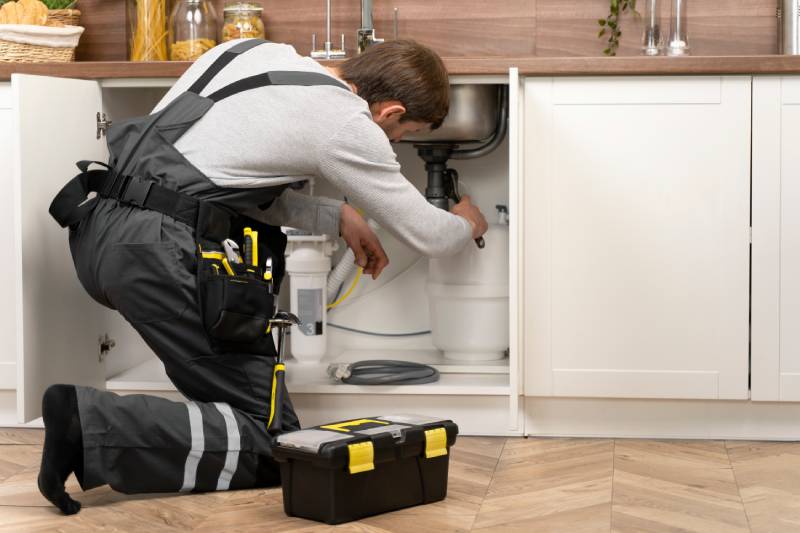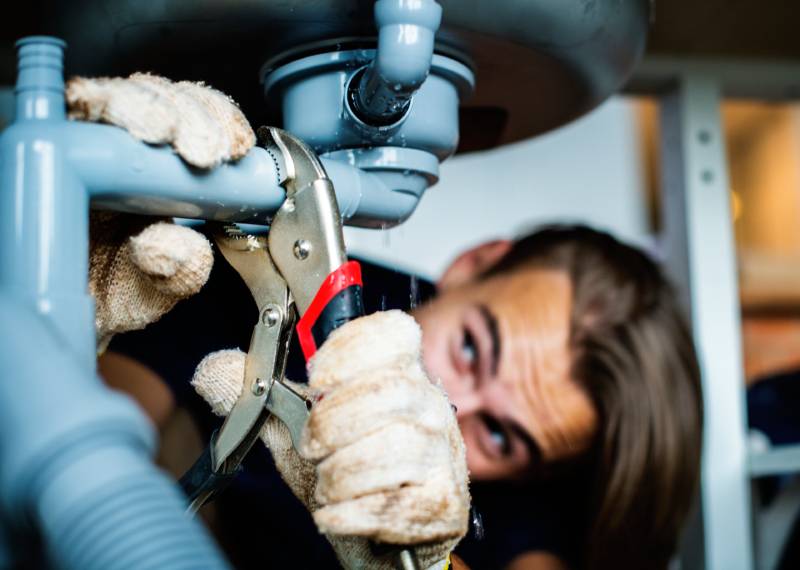
As the top plumbing company in Minneapolis, we receive many questions about ‘how to repair water damage.’ Whether it is caused by a faucet leak or other plumbing issues, you must act quickly to prevent further property damage. You could have wet walls or ceilings, sodden flooring, and even a mold outbreak. To make the restoration and repair process easier, this blog post discusses common signs of water trouble and different techniques to eliminate and repair water mess in your property.
Common Signs of Water Damage
If you notice any water dripping or stains, it’s essential to investigate the source of the water trouble promptly to prevent further deterioration and potential health hazards associated with mold growth. Water damage in properties can manifest in various ways, indicating potential issues with plumbing, roofing, or structural integrity.
Here are six common signs of water damage:
- Water Stains — Look for discoloration on walls, ceilings, or floors. Yellowish or brownish stains often indicate water seepage and subsequent staining from leaks.
- Peeling Paint or Wallpaper — Moisture can cause paint or wallpaper to bubble, peel, or crack. These are often indications of water seepage behind the surface.
- Musty Odors — Mold and mildew thrive in damp environments. A musty smell, especially in areas like basements, bathrooms, or under sinks, can suggest hidden water mess.
- Warped or Buckled Floors — Wooden floors that warp or laminate flooring that buckles are typical signs of water trouble. Water seepage can cause the materials to swell and distort.
- Sagging Ceilings or Walls — Excess water can weaken structural components, leading to sagging or bulging ceilings or walls, which can indicate long-term water exposure.
- Mold Growth — Visible mold or mildew growth is a clear indication of moisture buildup. Check areas prone to dampness, such as bathrooms, basements, or areas near leaking pipes.
8 Ways to Repair Water Damage In Minneapolis
Repairing water damage in homes and businesses requires a combination of assessment, mitigation, and restoration efforts. The specific repair methods will vary depending on the extent and nature of the damage, so it’s often best to consult with plumbing professionals who can assess the situation and recommend the most appropriate course of action.
Identify and Fix the Source
The first step is to identify and fix the source of the water trouble. This could involve repairing leaking pipes, fixing roof leaks, sealing cracks in the foundation, or addressing other structural issues contributing to water intrusion.
Water Extraction and Drying
Once the source of the water has been addressed, the next step is to remove standing water and thoroughly dry the affected areas. This typically involves using pumps, wet vacuums, and dehumidifiers to extract water and reduce moisture levels.
Mold Remediation
Mold can quickly grow in damp environments, so it’s essential to address any mold growth as part of the water mess repair process. This may involve removing affected materials, such as drywall or insulation, and thoroughly cleaning and disinfecting surfaces to prevent mold regrowth.
Structural Repairs
Depending on the extent of the water trouble, structural repairs may be necessary to restore the building’s integrity. This could involve replacing damaged wood, drywall, insulation, or other structural components that have been compromised by water.
Waterproofing
Implementing waterproofing measures can help prevent future water damage. This may include applying waterproof sealants to basements, crawl spaces, and exterior walls, installing sump pumps or French drains to redirect water away from the building, and ensuring proper grading and drainage around the property.
Replacing Damaged Materials
In cases where water damage has severely compromised building materials such as drywall, insulation, flooring, or cabinetry, it may be necessary to remove and replace these materials to ensure the structural integrity and safety of the property.
Repairing or Replacing Plumbing Fixtures
To prevent further water damage, leaky or damaged plumbing fixtures, such as faucets, toilets, or water heaters, should be repaired or replaced. This may involve fixing leaky pipes, replacing worn-out seals or gaskets, or upgrading to more efficient plumbing fixtures.
Call Professional Services
In cases of extensive water damage or when dealing with contaminated water (such as sewage backups or flooding), it’s crucial to enlist the help of professional plumbing services. These professionals have the expertise, equipment, and experience to safely and effectively mitigate water damage, sanitize affected areas, and restore the property to its pre-damaged condition.

Frequently Asked Questions
How long does it take to repair water damage?
The time it takes to repair water damage depends on various factors, such as the extent of the damage, the type of materials affected, and the drying methods used. Minor water damage may be repaired within a few days, while more extensive damage could take weeks or longer to fully restore.
Will my insurance cover the cost of water damage repair?
Whether or not water damage repair is covered by insurance depends on the type of policy you have and the specific circumstances of the damage. Generally, water trouble caused by sudden and accidental events (such as burst pipes or storm damage) may be covered, while gradual or neglected water mess may not be.
Can I repair the water damage myself, or do I need to hire professionals?
While minor water trouble repairs may be possible to tackle yourself, it’s often recommended to hire professionals, especially for significant or extensive damage. Professional water damage restoration companies have the expertise, equipment, and experience to properly assess and mitigate water damage, ensuring thorough and effective repairs.
How do I know if the water damage has caused mold growth?
Mold can start to grow in damp environments within 24-48 hours of water damage. Signs of mold growth include musty odors, visible mold growth on surfaces, and allergic reactions or respiratory symptoms in occupants. If you suspect mold growth, it’s essential to have the area inspected and tested by professionals.
Conclusion
If you decide to repair water damage yourself, we hope you find valuable information in this post. However, if the damage has severed or if you have any questions, you can rely on True Plumbing to respond to your projects around the clock. Contact us today.

